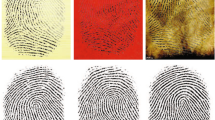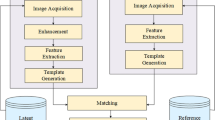Abstract
Biometric Authentication like Fingerprints has become an integral part of the modern technology for authentication and verification of users. It is pervasive in more ways than most of us are aware of. However, these fingerprint images deteriorate in quality if the fingers are dirty, wet, injured or when sensors malfunction. Therefore, extricating the original fingerprint by removing the noise and inpainting it to restructure the image is crucial for its authentication. Hence, this paper proposes a deep learning approach to address these issues using generative adversarial network (GANs) and Segmentation models. Qualitative and Quantitative comparison has been done between pix2pixGAN and cycleGAN (generative models) as well as U-net (segmentation model). To train the model, we created our own dataset – Noisy Fingerprint Dataset (NFD) ( NFD dataset. Last accessed at 5th September 2022. Available on https://drive.google.com/file/d/1ZxZpWL7U-wC5ukh_kash2H_l7b9J9su9/view?usp = sharing) by meticulously combining synthetically generated fingerprints with different textured backgrounds and further degrading the quality by adding noise and scratches to make it more realistic and robust. In our research, the u-net model performed better than the GAN networks; thus we conclude that segmentation models might be better suited to this task.
Access this chapter
Tax calculation will be finalised at checkout
Purchases are for personal use only
Similar content being viewed by others
References
Kaushal N, Kaushal P (2011) Human identification and fingerprints: a review. J Biomet Biostat 2.123: 2
Ramaswamy G, Sreenivasarao V, Guntur G (2010) A novel approach for human identification through fingerprints
Reddy GJ, Prasad TJC, Prasad MG (2008) Fingerprint image denoising using curvelet transform. Proc Asian Res Publishing Netw J Eng Appl Sci 3(3):31–35
Anguli: Synthetic Fingerprint Generator. Last accessed at 23rd October 2022. https://dsl.cds.iisc.ac.in/projects/Anguli/#about
Cimpoi M, Maji S, Kokkinos I, Mohamed S, Vedaldi A (2014) Describing textures in the wild. In Proceedings of the IEEE conference on computer vision and pattern recognition, pp 3606–3613
Singh K, Kapoor R, Nayar R (2015) Fingerprint denoising using ridge orientation based clustered dictionaries. Neurocomputing 167:418–423
Sahasrabudhe M (2022) Fingerprint Image Enhancement Using Unsupervised Hierarchical Feature Learning (Doctoral dissertation, Doctoral dissertation. Hyderabad: International Institute of Information Technology)
Khan HM, Venkadesh P (2022) Fingerprint Denoising Using Iterative Rule-Based Filter. Arabian J Sci Eng 1–15
Tang Y, Gao F, Feng J, Liu Y (2017) Fingernet: An unified deep network for fingerprint minutiae extraction. In: IEEE International Joint Conference on Biometrics (IJCB), pp 108–116. IEEE
Antony JK, Kanagalakshmi K (2021) T2FRF Filter: an Effective Algorithm for the Restoration of Fingerprint Images. Int J Image Graphics 2350004
Bradski G, Kaehler A (2008) Learning OpenCV: Computer vision with the OpenCV library. O'Reilly Media, Inc.
Salehi P, Chalechale A (2020) Pix2pix-based stain-to-stain translation: A solution for robust stain normalization in histopathology images analysis. In: 2020 International Conference on Machine Vision and Image Processing (MVIP), pp. 1–7. IEEE
Popescu D, Deaconu M, Ichim L, Stamatescu G (2021) Retinal blood vessel segmentation using pix2pix gan. In 2021 29th Mediterranean Conference on Control and Automation (MED), pp 1173–1178. IEEE
Creswell A, White T, Dumoulin V, Arulkumaran K, Sengupta B, Bharath AA (2018) Generative adversarial networks: an overview. IEEE Signal Process Mag 35(1):53–65
Isola P et al (2022) Image-to-image translation with conditional adversarial networks. In: Proceedings of the IEEE conference on computer vision and pattern recognition. Kushwaha V, Shukla P, Nandi GC (2022) Generating Quality Grasp Rectangle using Pix2Pix GAN for Intelligent Robot Grasping. arXiv:2202.09821
Harms J, Lei Y, Wang T, Zhang R, Zhou J, Tang X, Yang X (2019) Paired cycle-GAN-based image correction for quantitative cone-beam computed tomography. Med Phys 46(9):3998–4009
Kwon YH, Park MG (2019) Predicting future frames using retrospective cycle gan. In: Proceedings of the IEEE/CVF Conference on Computer Vision and Pattern Recognition, pp 1811–1820
Sim B, Oh G, Kim J, Jung C, Ye JC (2020) Optimal transport driven CycleGAN for unsupervised learning in inverse problems. SIAM J Imag Sci 13(4):2281–2306
Ronneberger O, Fischer P, Brox T (2015) U-net: Convolutional networks for biomedical image segmentation. In: International Conference on Medical image computing and computer-assisted intervention, pp 234–241. Springer, Cham
Du G, Cao X, Liang J, Chen X, Zhan Y (2020) Medical image segmentation based on u-net: A review. J Imaging Sci Technol 64:1–12
Siddique N, Paheding S, Elkin CP, Devabhaktuni V (2021) U-net and its variants for medical image segmentation: a review of theory and applications. Ieee Access 9:82031–82057
Paszke A, Gross S, Massa F, Lerer A, Bradbury J, Chanan G, Chintala S (2019) Pytorch: An imperative style, high-performance deep learning library. Advanc Neural Informat Process Syst 32
Abadi M, Barham P, Chen J, Chen Z, Davis A, Dean J, Zheng X (2016) {TensorFlow}: a system for {Large-Scale} machine learning. In: 12th USENIX symposium on operating systems design and implementation (OSDI 16), pp 265–283
Wang Z, Bovik AC (2009) Mean squared error: love it or leave it? A new look at signal fidelity measures. IEEE Signal Process Mag 26(1):98–117
Poobathy D, Chezian RM (2014) Edge detection operators: peak signal to noise ratio-based comparison. IJ Image, Graphics and Signal Processing 10:55–61
NFD dataset. Last accessed at 5th September 2022. https://drive.google.com/file/d/1ZxZpWL7U-wC5ukh_kash2H_l7b9J9su9/view?usp=sharing
Author information
Authors and Affiliations
Corresponding author
Editor information
Editors and Affiliations
Rights and permissions
Copyright information
© 2023 The Author(s), under exclusive license to Springer Nature Singapore Pte Ltd.
About this paper
Cite this paper
Patel, M., Patel, D., Patel, S. (2023). Comparative Analysis of Segmentation and Generative Models for Fingerprint Retrieval Task. In: Pandit, M., Gaur, M.K., Kumar, S. (eds) Artificial Intelligence and Sustainable Computing. ICSISCET 2022. Algorithms for Intelligent Systems. Springer, Singapore. https://doi.org/10.1007/978-981-99-1431-9_38
Download citation
DOI: https://doi.org/10.1007/978-981-99-1431-9_38
Published:
Publisher Name: Springer, Singapore
Print ISBN: 978-981-99-1430-2
Online ISBN: 978-981-99-1431-9
eBook Packages: Intelligent Technologies and RoboticsIntelligent Technologies and Robotics (R0)




